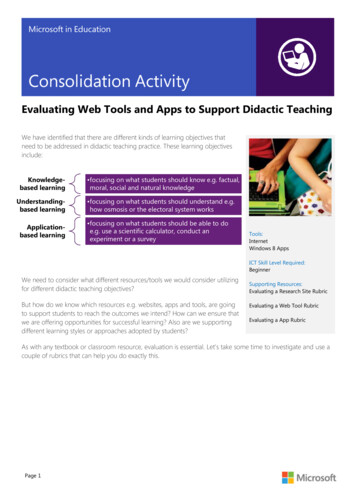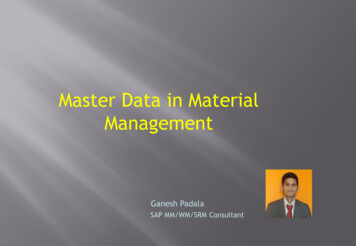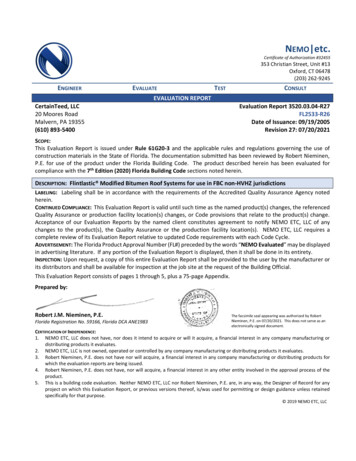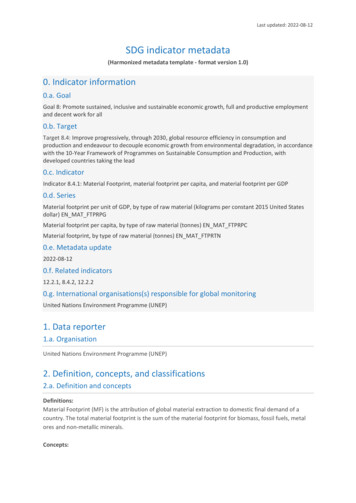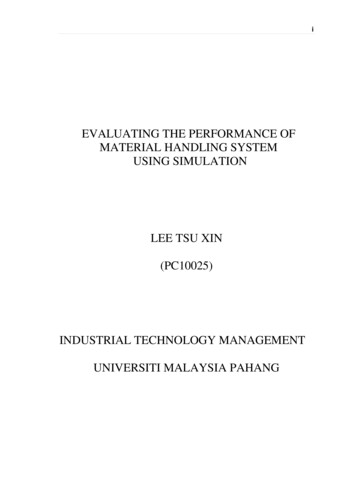
Transcription
iEVALUATING THE PERFORMANCE OFMATERIAL HANDLING SYSTEMUSING SIMULATIONLEE TSU XIN(PC10025)INDUSTRIAL TECHNOLOGY MANAGEMENTUNIVERSITI MALAYSIA PAHANG
viABSTRACTThis thesis discusses about the performance of material handling system at ricepackaging plant. The objectives of this thesis are to model the rice packaging processes,evaluate the performance of the process which include throughput and resourceutilization and improve the process. Arena, is the simulation software applied to modeland examine the performance of the system in this study. Resource allocation andmachine layout are important factors that affect to the efficiency of the process. Aftermodeling the processes in Arena, “what if analysis” strategy is implemented to enhancethe whole system by doing model experimentation. Integrating of simulation and “whatif analysis” provided a better model, achieved all the objectives of this study. We cansee improvements in term of the processing time, work in progress, resource utilizationand efficiency of the system at the end of the project. By using simulation, we can solvethe industrial problems without elevate production cost.
viiABSTRAKKajian ini membincangkan tentang prestasi sistem pengendalian bahan di kilang beras.Objektif kajian ini adalah untuk memodelkan proses-proses pembungkusan beras,menilai pencapaian proses termasuk daya pemprosesan dan penggunaan sumber sertamenambah baik proses tersebut. Arena ialah perisian simulasi yang digunakan untukmengkaji model dan sistem dalam kajian ini. Pengagihan sumber dan kedudukan mesinadalah faktor-faktor yang akan mempengaruhi kecekapan proses. Selepas memodelkanproses dengan Arena, strategi “What if analysis” telah diaplikasikan untuk meningkatanprestasi keseluruhan sistem dengan cara mengaji model. Integrasi antara simulasidengan kaedah “What if analysis” akan membentuk satu model yang lebih baik sertamencapai semua objektif kajian ini. Pada akhir projek ini, kami akan melihatpeningkatan sistem ini dari segi masa pemprosesan, kerja dalam proses, pengagihansumber dan kecekapan sistem. Dengan mengguna kaedah simulasi, kami bolehmenyelesaikan masalah industri dengan tidak menaikkan kos pengeluarannya.
viiiTABLE OF CONTENTPageSUPERVISOR’S DECLARATIONiiSTUDENT TviABSTRAKviiTABLE OF CONTENTSixLIST OF TABLESxLIST OF FIGURESxiLIST OF EQUATIONSxiiCHAPTER 1INTRODUCTION1.1Background of the study11.2Problem Statement31.3Objective of The Study41.4Research Question41.5Method of Analysis51.6Significance of Study71.7Scope of Study81.8Operational Definition8CHAPTER 2 LITERATURE REVIEW2.1Introduction92.2Material Handling System92.3Simulation102.4Application of Simulation in Industry12
ixCHAPTER 3METHODOLOGY3.1Introduction163.2System Description163.3Method of Data Collection193.4Modeling with Arena193.5What If Analysis21CHAPTER 4 RESULT AND DISCUSSION4.1Introduction234.2Analysis of Data Findings244.3Develop a Model of Rice Packaging Processes384.4Data Verification and Validation434.5Analysis of Simulation Result44CHAPTER 5 CONCLUSION AND RECOMMENDATION5.1Introduction545.2Result Discussion545.3Experimenting The model Using “ What If Analysis”Approach555.3.1 Scenario 1: What if adding one more entry pointand send worker 2 to conduct the transferring processat new entry point.5.3.2 Scenario 2: What if reducing waiting time of openclosed valve at tank 2 to constant, 10 minutes.5.3.3 Scenario 3: What if scenario 1 and 2 put EFERENCES68APPENDICES72A72Images of The Processes In Rice Packaging Plant
xLIST OF TABLESTable No.TitlePage4.1Inter-arrival time of rice sack at entry point254.2Waiting time of entity at tank 2324.3Service time of rice packaging process354.4Process sequence for production line404.5Operator working plan424.6Value added time for entity444.7Accumulate value added time per entity for entity time454.8Total time per entity for entity time464.9Resource utilization- worker utilization484.10Resource utilization- machine utilization494.11Wait time per entity504.12Queue at tank 2504.13Work in progress514.14Output summary- number in514.15Output summary- number out524.16Productivity of every process525.1Comparison of current and newmodel result of transferring process5.2Comparison of worker utilization of currentand new model5.35657Comparison of machine utilization of currentand new model585.4Comparison of productivity of current and new model585.5Comparison of waiting time625.6Comparison of wait in progress625.7Comparison of productivity for ever process635.8Comparison of worker utilization65
xiLIST OF FIGURESFigure No.TitlePage3.1System layout173.2Simulation study schematic214.1Distribution of inter-arrival time of rice sack at entry point 314.2Create module324.3Distribution of waiting time of entity at tank2344.4Module of tank 2 process344.5Module of destoning process354.6Distribution of service time of packaging process374.7Module of packaging process384.8Model of material handling system394.9Basic process of packaging line404.10Worker schedule414.11Run setup menu424.12Resource schedule435.1Final model605.2Changing on parameter(change value to 10 minutes)615.3Separate workers and assigned to two different paths615.4Line chart of work in progress62
xiiLIST OF EQUATIONSEquation No.4.14.24.34.44.5Inter-arrival TimeAverage of Inter-arrival TimeService TimeAverage Service TimeProductivityPage3131373754
1CHAPTER 1INTRODUCTION1.1 BACKGROUND OF THE STUDYMaterial handling system is an integrated system involving controlling, handlingstoring and transporting of materials (‘Automated material Handling System’ n.d.).Material handling system comprises of material requirement planning, scheduling,control of transportation resource, material handling equipment, delivery of materials,buffering and optimization of material. Effective material handling improves theefficiency of storing, controlling and utilizing of the materials along the productionprocess whereas ineffective material handling can leads to profit loss which is caused byidle part of the system, long queuing time and excessive WIP inventory in buffers.Performance of production process of a company is tightly related to the efficiency ofmaterial handling system. Hence, this research is proposed to analyse the movement ofmaterials and make improvements to the production process.“The food industry is a complex global collective of diverse businesses thatsupply much of the food energy consumed by the world population” (‘Food producers’2012). The global food industry comprises farming, food production, distribution, retailand catering. In this research, I am choosing JS Jasmine Sdn Bhd, a Selangor ricepackaging industry as my study target because competitiveness of rice market inSelangor is high due to the highest rate of population. Increasingly competitiveenvironment and market have forced food industries to seek improvements in theirproduction process to reduce operational costs.
2Simulation is an indispensible problem-solving methodology for many realworld problems. “Simulation is a process of creating a model of existing or proposedsystem in order to understand those factors which control the system or to predict thefuture behaviour of the system”(GoldSim Technology Group 2013). There are severaltypes of simulation models. Simulation model is classified to static simulation model,dynamic simulation model, deterministic simulation model, stochastic simulation model,continuous simulation model, and discrete simulation model (Anun.d.). Among abovesimulation models, combination of discrete and continuous simulation model ispreferred to use in the study. “Discrete event simulation utilizes logical model of aphysical system that portrays state changes at precise points in simulated time”(Mike2010). Discrete event simulation helps in checking for bottleneck, queue location andsizes and machine breakdown interval. Simulation is one of the methodologies toimprove and solve material handling issues in industries.Through observation and information given by manager of rice packaging factory,Mr Tee Jin Han, packaging line consists of workstations that perform the processes ofdestoning, polishing, colour sorting and packaging. There are four core machines,destoner, polisher, colour sorter and packaging machine work as leverages in productionprocess of the plant. Design, layout and performance of the machines and materialhandling equipments are affected to the productivity, production cost and efficiency ofthe process. However, performance of the machines is influenced by the amount andspeed of material flow. Packaging line is complex processes. “If the line is set upcorrectly, using the correct profiles of accumulation in conjunction with machine speeds,then any downtime experienced should be purely attributable to labour issues”(SakerSolution n.d.). Conversely, if the design is incorrect, performance of the overall systemmay be significantly degraded.Performance of material handling is important for industries. Therefore, Iproposed a research to evaluate the performance of material handling at packaging lineand find out alternative way for improving the process.
31.2 STATEMENT OF THE PROBLEMNormally, machines used in industries are set up by supplier’s company atstandard size, pattern and design. The rice packaging plant sometimes faces problem ofmachines jammed due to big bulk of rice block the machine. In addition, they do nothave experts or engineers to take care of the machines. Currently, they depend on atrainee who sent from supplier to clean machines and doing maintenance once a weekbasis. Through information I received, when machines go to rebellious, the plant haveto stop the process and use a lot of time to find out the sources of the problem. Thisissue may incur higher operational cost. Therefore, I recommended simulation methodto be used to enhance the system. Simulation modeling can let researcher look details toeach part of the material handling equipment layout and performance of the process.Simulation provides easier way for us to find the sources of industrial problems whichcaused by mistakes on resource allocation.Today’s world, companies are often face with increased requirements forproductivity, accuracy and reliability, while at the same time contending with increaselabor expenses and stuff reduction. This issue is confronting every company. Resourceallocation is affected to company financial management. In this research, I will usesimulation methodology to evaluate the performance of the processes includingthroughput and resource utilization to help in improving processes without highresource expenses.Quantity demanded to every product is not the same. Quantity demandeddepends on the price of good or service in the marketplace, regardless of whether thatmarket is in equilibrium. Quantity demanded of rice alters sometimes due to changes ofmarket price. In this case, rice packaging plant must ensure its productivity can achievecustomer’s demand to prevent stock out. Productivity of the industry is depends on theefficiency of the machines. For improving the process, what if analysis can help out.What if analysis is sensitivity analysis which used to compare different scenarios andtheir potential outcomes based on changing condition. We can know what will happen ifwe do amendment on some parts of the material handling equipment or system.
41.3 OBJECTIVES OF THE STUDYThe objectives of this study are:i.To model the rice packaging processes using simulation.ii.To evaluate performance of the process which include throughput and resourceutilization.iii.To experiment different strategy for improving the process.1.4 RESEARCH QUESTIONI.What are the problems of material handling in the rice packaging plant?II.How does simulation method improves the process and solves the problems?III.How does what if analysis improves the process?
51.5 METHOD OF ANALYSISSimulation is a flexible methodology we can use to analyse the behaviour of apresent or proposed production line, business activities, packaging line or plantexpansion. In a simulation, we perform experiments on model of the real system withfaster, cheaper and safer way.Simulation steps are shown as follow:1. Problem Formulation2. Setting of objectives and overall project plan3. Model building4. Data collection5. codingNoNo6.Verified?YesNo7.Validated?Yes8. Experimental design9. Production runs and analysisYes10.More runs?YesNo11. Document program and report results12.Implementation
61.Problem formulation: Problem must be identified with a set of assumptions bysimulation analyst as simulation study progresses.2.Setting of objectives and overall project plan: Prepared a proposal whichcomprised of clear and achievable objectives. Project plan must includedscenarios that will be investigated and elements used to solve the problems.Elements consist of hardware, software and time.3.Model building: Built and developed model in this stage. Begin with draw asimple model and grow it until an accurate complexity model form. For instance,consider a model of material handling system, construct a basic model witharrivals, queues, and servers then add material handling capabilities and specialfeatures afterward.4.Data collection: Data can collect from company after proposal is accepted. Datacan be anticipated if they found data are quite different. Simulation analyst canreadily construct model when data is collected at the same time.5.Model translation: The conceptual model is coded into an operational model.6.Verified?: Check whether it is perform correctly with an interactive run controller.7.Validated?: Validation is a determination to the accuracy of the model inrepresenting of the real system. Compared output of the model to the base system,existing system is the best way in doing validation.8.Experimental Design: Considered length of simulation run, number of runs andmanner of initialization.9.Production runs and analysis: It is used to estimate performance of the scenariosthat are being simulated.10.More Runs?: Can add any simulation scenarios and runs based on analysis.11.Documentation and reporting: Documentation is important for analyst tounderstand the simulation model operates. The result of all analysis should bereported clearly and concisely. This will enable the company to review the finalformulation by comparing alternative systems, results of experiments and analystrecommendation.12.Implementation: Report prepared at step 11 as information to company formaking decision. Manager can choose to run or not to run the plan at the realplace.
71.6 SIGNIFICANCE OF STUDYThe main aim of this particular study is to analyse the implementation ofmaterial handling system at packaging line of food industry.This research is to improve the efficiency of the processes. Every part ofproduction process is important to rice packaging line. Simulation method can help insolving problems which faced at the packaging line. Besides, manager can manage andcontrol the process easily through running simulation model. The industry can save costand time to find out sources when problems happen.Besides, this study will significantly shows how the material handling layouteffects to the performance of whole process. Material handling plays an important rolein supply chain. In supply chain, material handling functions to handle a bulk ofmaterials over short distance. Material handling also functions at lifting the storage toanother place during order picking, moving material for checking and packing, loadingthe packaging carton on to the transport vehicles, unloading incoming material fromtransport vehicles and shifting the unloaded material to arrange storage place inwarehouse(Scople 2007). Hence, developing of material handling can enhances theperformance of supply chain management in industries.Moreover, this study also helps to test the real situation of rice packagingprocesses at rice packaging plant with computer software. By using Arena and what ifanalysis, we can know the productivity that company achieved via testing withcollective data. These data include amount of labour in every station and processingtime of every process. Production cost is a main issue that concerns by every industry.Improving the processes with simulation can help company to increase its efficiency ofthe production without elevate production cost.Lastly, this research can aids manager to enhance the speed of the productionand reduce the rice processing time.
81.7 SCOPE OF STUDYIn this research, we focus on rice packaging industry in Selangor, Malaysia.Material handling System that used in that rice packaging company is my researchtarget. Proper implementation of material handling will contribute profits whereasimproper material handling design will cause loss.Today competitive business world forced industries struggling to find ways forimproving their material handling system including equipment, design and layout.Simulation will use in this research to evaluate and improve the performance of materialhandling system. First, layout of the machine will model out with Arena, then identifyproblems through simulation model and redesign a new model which is more effective.Finally, test the result and compare the outcomes with real system. We will look overthe machine utilization, worker utilization, productivity and processing time of thesystem after modify the model. We can also evaluate performance of the processesincluding throughput and resource utilization by analyzing simulation result. On theother hand, different strategy, what if analysis will use to improve productivity bytesting on different scenarios.Thus, rice packaging plant will be the context here, I will analyse materialhandling and performance of the process at packaging line via simulation modeling andwhat if analysis methods.1.8 OPERATINAL DEFINITIONKey TermsDefinitionMaterial handlingShort distance movement of goods or materials within a storagearea, involving loading, unloading, palletizing, de-palletizing andso on.Material handlingIt refers to activities, equipment and procedures related to thesystemmoving, storing, protecting and controlling of materials in asystem.Material handlingThey are mechanical devices for handling of supplies with greaterEquipmentease and economy.
9CHAPTER 2LITERATURE REVIEW2.1 INTRODUCTIONA material handling system is an integrated system involving activities such ashandling, storing and controlling materials. “The primary objective of using a materialhandling system is to ensure that the material in the right amount is safety delivered tothe desired destination at the right time and at minimum cost”(‘Automated MaterialHandling and Storage Systems’ n.d.). Implementing incorrect design of materialhandling system can incur problem to the packaging line. Simulation will use in thisresearch to study and enhance the processes of rice packaging line.2.2MATERIAL HANDLING SYSTEMMaterial flow is a significance factor of food packaging processes. Goodmaterial handling system is able to supply components with raw materials, tools andconsumables at desired rate and time. Material handling works along each individualpart of packaging line to form a whole. Advantages of material handling system areincrease productivity, save time and cost, reduce materials inventory, provide betterworking condition, make improvement in quality and reduce damage to materials.Proper material handling can allocate manpower well and increase systemflexibility(Chan 2002).
10Cliff Holste, a Supply Chain Digest’s Material Handling Editor(Cliff 2013) saidthat improved system throughput capacity and system reliability was brought to 10% to25% of benefits. It is rather update or improve Material handling system than replacethe breakdown machine. Manufacturer can save overall cost of production by enhancingmaterial handling system instead of buying new machine.On the other hand, W and H systems designed and implemented a materialhandling system that incorporated warehouse control system, voice picking technology,conveyor systems, a high speed unit sortation picking and shipping sortation hasachieved a 45% increased in productivity and a 60% reduction in pick errors. Bettermaterial handling system make the process run smoother(Carlstadt, N.J 2012).Furthermore, delivery service to the customers can also improve throughenhancing the material handling system. Tesco is one of the companies that possessedthis kind of benefit by implemented new material handling system called automatedmaterial packing and handling. Tesco practiced new system on January 2012 and itsucceeds to increase volume of order picking while retained high service level at thesame time. Tesco fulfilled an increase number of home delivery grocery orders fromone location with lower running costs (Bowling 2013). Automated material handlingsystem also increased the efficiency of dedicating a warehouse to home-deliveringorders made online.Enhancing material handling system is one of the best ways to significantlylower company’s operating costs. Good material handling systems help in accelerate theoperation of the production and increase the efficiency of production process. Materialhandling system has positive effects on almost everything run in food industry.Historical cases showed that improve material handling system can help managers inhandling the materials of the production processes better. In Industrial field, simulationis one of the efficient tools to study, improve and solve material handling problems.2.3 SIMULATIONSimulation is favourite technology that used by researchers in solving scenariosand doing material handling design. “In recent year, there has been a tremendousgrowth of material handling technologies and equipment types such as robots,
11automated guided vehicle(AGV), electrified monorail system(EMS), high-rise storageretrieval system, computerized picking, systems and computer controlled conveyorsystems”( Ulgen&Upendramn.d.). Material handling projects are often costly withpotential risk. To implement it well in industry, simulation technology can be used as atest-bed to better understanding the system. Simulation can help to address complexdesign, operational, business and scheduling problems. Simulation can classify into fourphase, the conceptual phase, detailed design phase, launching phase and full operationphase.Simulation was known and used by people to solve industrial problems longtime ago. In the year 1968, a second conference on the application of simulation washeld in New York Hotel, Roosevelt with seven hundred attendees. The conference wasthe first one to issue many aspects of discrete event simulation. Topics related discreteevent simulation that discussed in the conference were sessions covered transportation,computer systems, manufacturing applications, reliability and maintainability, graphicsand GPSS modification, job shops, material handling, facility planning model and so on.After that, in year 1970 and 1971, third conference, fourth conference and fifthconference were held in western countries to discuss simulation method. Many schoolswere offered continuous and discrete event simulation course at that time.(Simulationand Modeling Teamn.d, ‘Introduction to modeling and simulation systems’, para. 16).Simulation was studied by many manufacturing designers, engineers,researchers and scientists. Today, many types of simulation were developed by experts.Now, simulation method is used at many sites including hospital, bank, petrol station,manufacturing plant, aerospace, company and so on. A great man, Jeremy J. S. B., isone the world’s leading designer and provider of business simulations for managementdevelopment and business training. Since 1970, he has developed sixty-five computersimulations comprehensively covering management learning across industry. Heprovided big contributions to simulation. (Jeremy 2012).Simulation is a tool to managing change. Simulation can use in business process.Simulation accelerates business people make change of the way they are doing business.Business Process Simulation(BPS) is type of technique which use in making accuratebusiness decisions. It support by several software tools. Software tools that may beapplicable for business process simulation are business process modeling tools, business
12process management tools, general purpose simulation tools. For evaluation ofsimulation functionality, we consider Petri Neys(Protos) and Event-driven processchains(ARIS Toolset). Business process management tools supports business designphase, functions to evaluate Flower tool and FileNet. For general purpose simulationtools, we consider Arena and CPN tools.In this study, Arena is chosen as simulation tool to do simulation modeling.Arena is a general purpose simulation instrument developed by Rockwell Automation.Arena is a discrete event simulation software which developed by Systems Modeling.Arena product family consists of a Basic Edition for uncomplicated process and aProfessional Edition for more complex large scale projects in manufacturing,distribution, processes, logistics and so on. “As of June 2012, Arena was in version 14and it has been suggested to join Rockwell software packages under “Factory Talk”brand(Arena Simulation Software, 2013). This software is suitable used to buildsimulation models. Arena can solve any industrial problems including complex andintricate cases. When opening Arena, we can see three modules, basic process, advancetransfer and advance transport. Arena can make analysis of the data easily and moreeffective compared to manual calculation.People started study simulation many years ago and its importance was affirmedby many industries. Even today, some high education institutions are focus on studyArena, simulation modeling. This technology makes manger’s tasks easier in managingmachine, people, resource, business and time.2.4 APPLICATION OF SIMULATION IN INDUSTRYAs15 February of 2013, there is news of Today’s Medical Development claimedthat simulation now recognized by FDA as essential to medical device evaluation. Liu C.reported that solid mechanics simulations can help determine proper implant size,evaluate manufacturing tolerances, compare design geometries or consider next-gendevices. Furthermore, simulation-based product can be linked in automated workflows,optimizing large quantities of design data for creating patient-specific medical tools.Simulations with Abaqus finite element analysis(FEA) was solved the toughestchallenges of design engineering with increase the accuracy in evaluating device
13performance. Recognition of simulation by FDA was proven that simulation not onlyuseful in manufacturing industry but also medical care (Cheryl 2013).Computer simulation already widely accepted in many industries. For example,the case of Hughes Aircraft succeeds to design automated storeroom system throughsimulation application in the year 1990. He was combine six storeroom into single,automated facility using simulation method. The simulation modeling product whichHughes chosen for this project is WITNESS. Hughes integrated powered conveyor,double stacked horizontal carousel, robotic inserters and tote pans and many othercomponents into one operation system using WITNESS on a standard IBM PC/AT orPS/2 system. (Thomas & Charles 2013).Through simulation, objectives of this projectwhich to receive store and issue material in an efficient and economical manner andensure inventory accountability ware achieved. Hughes Aircraft achievements wasproven that simulation is pretty suitable used for researcher in solving material handlingproblems.There are many types of simulations were developed by experts. Computerbased scenario simulation is one of them. “Computer-Based scenario simulationsometimes called “best-practice” simulations, are used to build leadership, projectmanagement, and sale capabilities”(BTS n.d.).This simulation supports decision treestructures in realistic story lines, enhance with text audio, still photography, and video.Simulation imitates the realistic of real situation.Users are given chance to observe realworld business situation then they react to the issue presented. Upon choosing course ofaction, the simulation will present the effects of the participant’s decisionsimmediatelyon the goals.Scenario core structure at below will make reader moreunderstand to the functions of computer-based simulation.Scenario core structure:
14Simulation was used in many applications. Study of Brazilaian petroleumindustry applied human modeling and simulation tools to assist in the ergonomicsdesigns of new petrol chemical industry facility is the example of using simulation inchemical industry. In this case study, that industry employed 3D modeling software anddigital 3D human mannequins. Digital human simulation helped in doing decisionmaking about the technical systems and workplace conception. According to Danieal,Nilton, Joao &Michel(2009), simulation has three steps: Analysis of reference situation Identification of situation characteristics Future activity simulationSimulation characteristics in situation accurately reflected the future implementations offloorplans, prototype and simulation software.Queuing systems can improved through simulation method. Based on paper,“An Integrate Artificial Neural Network-computer Simulation for Optimization ofComplex Tandem Queue System”, intelligent simulation environment utilized computersimulation and Artificial Neural Network( ANN ) to stimulate and optimize tandemqueuing systems. This study is able to solve the states, conditions and operations of thesystem in manufacturing industry (Azadeh et al. 2011, p.666-678). Simulation can solvemany industry problems especially issues at produc
storing and transporting of materials ('Automated material Handling System' n.d.). Material handling system comprises of material requirement planning, scheduling, control of transportation resource, material handling equipment, delivery of materials, buffering and optimization of material.



